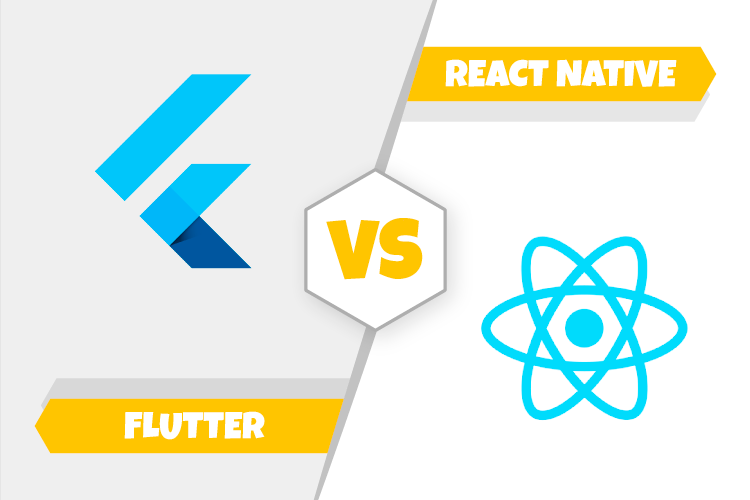Flutter vs React Native
Cross-platform app development has been a tedious task for any
mobile app developer. When talking about hybrid apps, the development goes with writing the code once and building apps with the same that runs smoothly on all of the platforms without the need of any additional efforts. All of these are possible with the help of a variety of frameworks that are available in the market- this includes the much talked about frameworks like React Native from the social media giant Facebook and Flutter from the Google.
React native is a js framework that is used for building native mobile apps. It uses the react framework and offers a huge amount of inbuilt APIs and components. With React native you don't build a mobile web app, an HTML5 app, or a hybrid app; rather you are building a real mobile app that is indistinguishable from an app that is built using Objective-C or Java. React Native uses the same fundamental UI building blocks as they are used in regular iOS and Android apps. You just put these strong building blocks together using JavaScript and React.
Whereas, Flutter allows developers to
build apps for both the iOS and Android at the same time while using the same exact code. This may sound like a giant leap for Flutter but there is still a long way to go in catching up with React Native.
Before start discussing Flutter vs React Native in detail, let's have a look at the basics of Flutter and React Native.
Flutter
Flutter has been publicly available for less than three years and it only started gaining visibility in the development field around a year ago. It is a technology that has been developed by Google that builds upon Dart and a portable C++ engine to implement reactive UI framework. Regardless of lesser love that Dart is receiving in the StackOverflow developer survey, the early blog posts have been positive about the use of Flutter.
However, staffing team won't be that easy as the platform is so new and
Dart is a niche language, but it can easily be picked up by Kotlin and Java developers. Here, upskilling an existing mobile team would be better for Android Developers as Flutter can easily integrate with IntelliJ as well as Android Studio. The situation becomes problematic for iOS developers as they need to get used to tooling and the language; which could be a bit more difficult.
In Flutter app development, apart from the Bluetooth API and NFC payments, most of the hardware and sensor APIs are supported but some of them are at their initial stages of development. Still, a lot of plugins already exist, but some areas are more inflow than others. For example, inline video support and dynamic inline maps are still under development, but full screen and static maps are supported.
Conclusively, when it comes to testing, it becomes very clear that Flutter is a new framework. Dart offers an excellent unit testing that can be utilized and flutter offers you a great unit testing framework that can be utilized. It allows you to run performance tests with its flutter_driver package.
React Native
The framework was released as an open source on GitHub in the year 2015 and is the most popular of the two frameworks on Google and Stack Overflow. Despite being a semi-matured framework, there is no clear roadmap, just a dedicated page on GitHub that lists placeholders. Staffing in React Native is comparatively easier but the React Native app developers aren't an ordinary thing; finding native mobile app developers who have knowledge of React and JavaScript as well, could result in a tall order.
React Native supports the majority of Android and iOS native APIs. Due to its huge developer community, even if there is no official API available there are plenty of third-party APIs are available to choose one from. In terms of hardware specific APIs, React Native lacks a number of them; again, third-party libraries are also available. React Native doesn't have impressive APIs for Bluetooth, NFC, camera, sensors, and more. The React Native app developers have all JavaScript frameworks that are available for testing at a unit level. However, when it comes to UI/automation testing the situation becomes quite complex.
Related:
Flutter vs React Native Performance
Let's have a look at the insights based on Flutter vs React Native Performance in which Flutter is better than React Native and vice versa!
Things in which Flutter is better than React Native
- The Stateful Widget in Flutter that provides a place that helps to store and change data dynamically that would be similar to react and react native.
- The recommended IDEs for Flutter app development include Android Studio and IntelliJ Idea. These are easy and awesome to work with for a developer who has already worked on Android.
- Although React Native has Hot Reload, it is not as fast as Flutter.
- With React Native the situation becomes difficult as it comes to the selection of navigator because of no navigator in React.
Native is 100% perfect. On the other hand, the built-in navigator in Flutter is amazing. You can easily create a new route without connecting anything. Dissimilar to React Native where you can import navigation components every time.
Things React Native is better at than Flutter
- Styles aren't separated in Flutter, you would need to give inline styling while creating each component.
- Flutter is known for Animation and UI customization, however, it is comparatively more difficult to implement animations in flutter than in React Native.
- Flutter doesn't have enough resources to fix things up as till date it hasn't received much attention from StackOverflow. This makes it harder for the developers to quickly build applications.
- Modularity in Flutter never exists. It is almost impossible to inherit one component into another in Flutter app development.
Related:
Hybrid App vs Native App
Future of Flutter
Flutter would be better if they bring up a separate place for styling and a construct for reusing code. Until then you can try solving the issues open over
GitHub.

